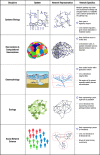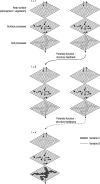Connectivity and complex systems: learning from a multi-disciplinary perspective
- PMID: 30839779
- PMCID: PMC6214298
- DOI: 10.1007/s41109-018-0067-2
Connectivity and complex systems: learning from a multi-disciplinary perspective
Abstract
In recent years, parallel developments in disparate disciplines have focused on what has come to be termed connectivity; a concept used in understanding and describing complex systems. Conceptualisations and operationalisations of connectivity have evolved largely within their disciplinary boundaries, yet similarities in this concept and its application among disciplines are evident. However, any implementation of the concept of connectivity carries with it both ontological and epistemological constraints, which leads us to ask if there is one type or set of approach(es) to connectivity that might be applied to all disciplines. In this review we explore four ontological and epistemological challenges in using connectivity to understand complex systems from the standpoint of widely different disciplines. These are: (i) defining the fundamental unit for the study of connectivity; (ii) separating structural connectivity from functional connectivity; (iii) understanding emergent behaviour; and (iv) measuring connectivity. We draw upon discipline-specific insights from Computational Neuroscience, Ecology, Geomorphology, Neuroscience, Social Network Science and Systems Biology to explore the use of connectivity among these disciplines. We evaluate how a connectivity-based approach has generated new understanding of structural-functional relationships that characterise complex systems and propose a 'common toolbox' underpinned by network-based approaches that can advance connectivity studies by overcoming existing constraints.
Keywords: Connectivity Studies; Emergent Behaviour; Functional Connectivity; Fundamental Unit; Measuring Connectivity; Structural Connectivity.
Conflict of interest statement
The authors declare that they have no competing interests.Springer Nature remains neutral with regard to jurisdictional claims in published maps and institutional affiliations.
Figures






References
-
- Albert R, Barabasi A-L. Statistical mechanics of complex networks. Rev Mod Phys. 2002;74:47. doi: 10.1103/RevModPhys.74.47. - DOI
-
- Altermatt F. Diversity in riverine metacommunities: a network perspective. Aquat Ecol. 2013;47:365–377. doi: 10.1007/s10452-013-9450-3. - DOI
-
- Ascher W. Coping with complexity and organizational interests in natural resource management. Ecosystems. 2001;4:742–757. doi: 10.1007/s10021-001-0043-y. - DOI
Publication types
LinkOut - more resources
Full Text Sources
